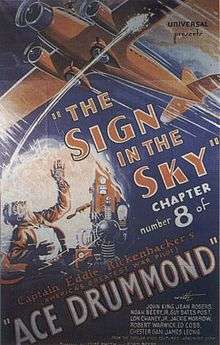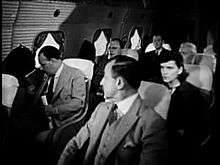Ace Drummond (serial)
| Ace Drummond | |
|---|---|
 Film poster for Chapter 8 | |
| Directed by |
Ford Beebe Clifford Smith |
| Starring |
John 'Dusty' King Jean Rogers Noah Beery, Jr. Lon Chaney, Jr. |
| Cinematography | Richard Fryer |
| Distributed by | Universal Pictures |
Release dates | 1936 |
Running time | 13 chapters (258 min) |
| Country | United States |
| Language | English |

Ace Drummond is a 1936 film serial based on the Ace Drummond comic strip drawn by Clayton Knight and written by Eddie Rickenbacker. The serial's cast features John King, Jean Rogers, Noah Beery, Jr. and Lon Chaney, Jr..
Plotline
A mysterious villain who calls himself The Dragon is attempting to prevent International Airways from beginning service in Mongolia, in order to protect the secret of the mountain of jade for himself. It features a dungeon in the nearby monastery, the kidnapping of an archeologist who stumbles onto the secret, his daughter's attempts to rescue him with Ace's help, a death ray The Dragon uses on the airline pilots, a radio system by which The Dragon communicates with his henchmen via the rotation of Buddhist prayer wheels (each transmission concluding "The Dragon commands!"), and a squadron of his own fighter planes.
Cast
- John King as Ace Drummond
- Jean Rogers as Peggy Trainor
- Noah Beery Jr. as Jerry
- Guy Bates Post as the Grand Lama
- Lon Chaney, Jr. as the henchman Ivan
- Jackie Morrow as Billy Meredith
Production
Ace Drummond was based on a comic strip by Captain Eddie Rickenbacker.[1]
Ace Drummond gained good publicity following a set visit by Amelia Earhart. The famous aviator had driven out to the San Fernando Valley, after hearing that the serial was being shot there on location, where she watched the filming of the chapter two cliffhanger.[2]
In the traditional foreword at the beginning of each chapter, Ace Drummond used comic strips to summarise the story so far. This worked well and Universal, who had been trying to get away from using written text in its forewords, used "similar gimmicks" in their succeeding serials.[2][3]
Music
Ace also regularly performs his theme song, "Give Me a Ship and a Song".
Critical reception
In the words of Cline, Ace Drummond "exuded the futuristic aura of Flash Gordon combined with the eerie mystery of Baron Frankenstein's castle laboratory."[4]
Chapter titles
- Chapter 1 - Where East Meets West
- Chapter 2 - The Invisible Enemy
- Chapter 3 - The Doorway of Doom
- Chapter 4 - The Radio Riddle
- Chapter 5 - Bullets of Sand
- Chapter 6 - Evil Spirits
- Chapter 7 - The Trackless Trail
- Chapter 8 - The Sign in the Sky
- Chapter 9 - Secret Service
- Chapter 10 - The Mountain of Jade
- Chapter 11 - The Dragon Commands
- Chapter 12 - The Squadron of Death
- Chapter 13 - The World's Akin
Source for titles:[5]
See also
References
- ↑ Cline, William C. "2. The Perils of Success". In the Nick of Time. McFarland & Company, Inc. p. 17. ISBN 0-7864-0471-X.
- 1 2 Harmon, Jim; Donald F. Glut. "7. The Aviators "Land That Plane at Once, You Crazy Fool"". The Great Movie Serials: Their Sound and Fury. Routledge. pp. 149, 151. ISBN 978-0-7130-0097-9.
- ↑ Stedman, Raymond William. "5. Shazam and Good-by". Serials: Suspense and Drama By Installment. University of Oklahoma Press. p. 138. ISBN 978-0-8061-0927-5.
- ↑ Cline, William C. "3. The Six Faces of Adventure". In the Nick of Time. McFarland & Company, Inc. p. 32. ISBN 0-7864-0471-X.
- ↑ Cline, William C. "Filmography". In the Nick of Time. McFarland & Company, Inc. pp. 215–216. ISBN 0-7864-0471-X.
External links
| Wikimedia Commons has media related to Ace Drummond. |
- Ace Drummond at the Internet Movie Database
- Ace Drummond at AllMovie
- Ace Drummond at Internet Archive
| Preceded by The Phantom Rider (1936) |
Universal Serial Ace Drummond (1936) |
Succeeded by Jungle Jim (1936) |